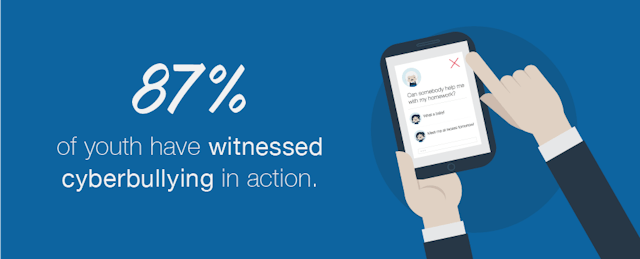“We live in a world today where everything we do can be tracked,” says Shannon Bischoff, Technology Facilitator at Toledo Public Schools in Ohio. She believes we need to teach students about digital safety “and how to make appropriate choices online.”
At Learning.com, we work hard to do just that, by supporting educators with a positive, researched-based curriculum that offers a rich exploration of digital citizenship topics. Those of us creating, working in, and teaching technology are greatly concerned about how we can help make the internet a safer and better place for all—especially children and young people.
The youth cyberbullying statistics we continuously run across are dramatic and worrisome. One in three young people have experienced online threats, a rate that has nearly doubled from 2007 to 2016. In 2015 alone, the Center for Disease Control reported that 15.5% of high school students and 24% of middle school students were cyberbullied. What’s more, 87% of youth have witnessed their peers being cyberbullied. Yet the National Crime Prevention Council suggests that only 11% of teens have talked to their parents about incidents of cyberbullying.
While Learning.com has long contributed resources—such as videos, trainings, lesson plans, and webinars—promoting digital citizenship and online safety, we are taking bolder steps to show our personal commitment to raising awareness and helping educators take preventative action to stem this epidemic.
Going Blue
October is National Bullying and Cyberbullying Prevention Awareness Month, and the first Monday in October is Blue Shirt Day®, organized by STOMP Out Bullying. Organizations, schools, and communities around the world are invited to Go Blue and join together in solidarity to stop bullying and cyberbullying.
This year, Learning.com is participating in the cause by creating #BeKindOnline shirts as well as a short video that provides cyberbullying prevention tips for educators to share with their students. We are also giving away free lesson plans about online safety topics and holding a Twitter contest to give educators a chance to win a #BeKindOnline shirt.
A Safer Digital World
As educators, it is our job to arm students to succeed in the digital community in which they’re growing up. And at Learning.com, we’re passionate about helping all teachers equip their students with the skills they need to stay safe online. To do that, we’ve developed curriculum that provides a positive approach to engaging students on challenging subjects such as:
- Cyberbullying awareness and prevention — knowing how to handle offensive or insulting messages, when to show messages to a teacher or parent/guardian, and why it’s important not to be a silent bystander when witnessing cyberbullying
- Safe use of social networks — focusing on how to stay safe on social media platforms, how to create and store passwords, and how to identify and how to avoid computer viruses
- Texting and online communication etiquette — learning to effectively communicate using all forms of technology and understand responsibilities within a digital environment
- Protecting personal information — realizing what information should and should not be shared in specific situations
Leading the Way
Our complete online safety instructional solution includes teacher guides and resources for parents and guardians—in both English and Spanish—to bridge the gap between school and home. During the past five years, more than 2.2 million students have benefited from our online safety curriculum.
As we focus on providing resources for online safety, it is our hope that the Be Kind Online program highlights our commitment to cyberbullying prevention and education. Throughout the month of October, we will share many other resources, including free online safety lessons and a Continuing Education Certificate webinar through edWeb.
As Toledo Public Schools’ Bischoff says, “students need to be aware that choices they make today can have an impact on their future.” Wearing our blue shirts, we stand in solidarity with communities everywhere that are engaged in the important work of creating a safer digital future for all children.
Be Kind Online Ideas for Students
Talking about cyberbullying in the classroom can be challenging and complex. Here are some easy-to-remember guidelines to share with students.
- Pause Before You Post—Be kind and smart about what you post or write online to others. Do not share anything that could hurt or embarrass yourself or your peers.
- Use Computer Courtesy—Whether you are sending an email, talking in a chat room or speaking in a forum, it is important to be courteous and respectful of others when you are online. Internet users of all ages should observe the golden rule: treat others as you want to be treated.
- Not Sharing is Caring—Keep passwords safe, and don’t share them with friends. Sharing passwords can compromise personal control over your online identity and activities. Also, be sure to logout of all accounts when you leave your computer. That way, no one can access your info.
- Speak Out & Reach Out—Always stand up for yourself online. If you see friends or classmates engaging in cyberbullying, seek help from an adult or teacher. Reach out to a target bullying and offer your support.



